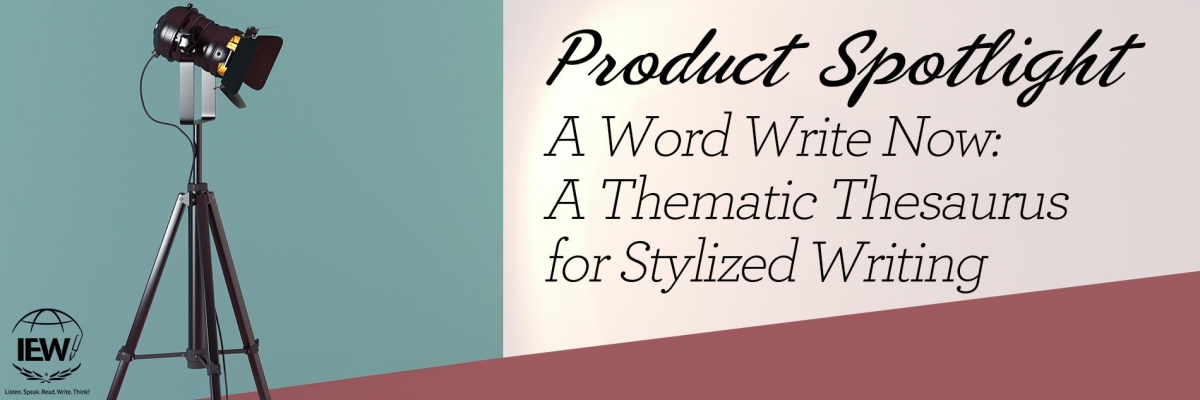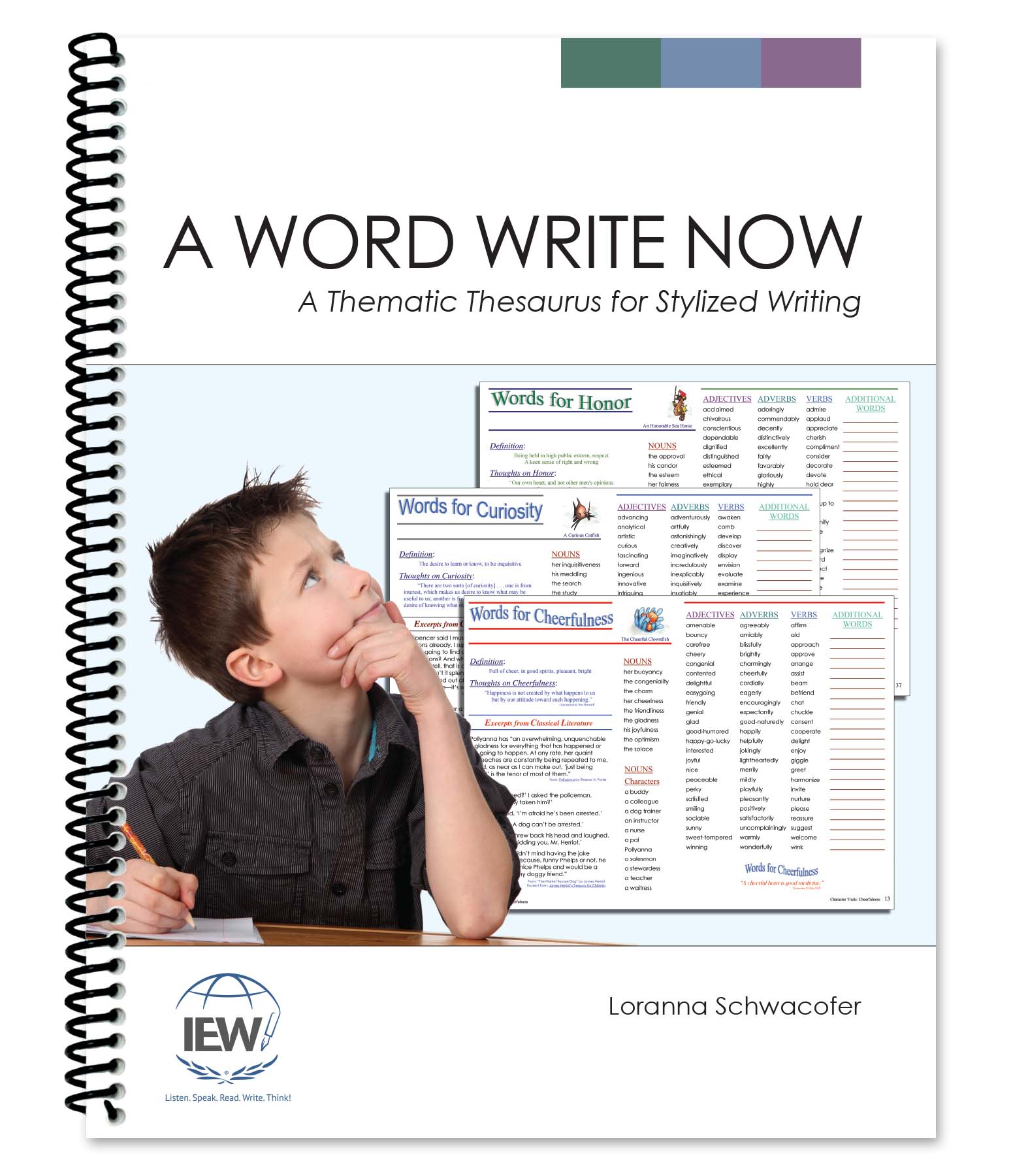
Getting students to write using vivid language is easier said than done. Asking them to  “show, not tell” when they write or to write in a way that creates a movie in the reader’s mind is a concept too abstract for most kids to understand, let alone know how to do. To make the concept concrete, teachers must model descriptive writing, provide lots of examples of expressive language, and give students lists of words to “prime the pump” before they write. If the teacher struggles to think creatively at the moment (a lot of us do), modeling what we want can be intimidating. IEW has the perfect resource for students—and their teachers. Designed as a character-based thesaurus, A Word Write Now (WWN) by Loranna Schwacofer is organized by character qualities and behavior traits. This student-friendly reference book is printed in full color on glossy pages (designed to endure lots of handling) and arranged in four sections that make it easy to find the words that make stories and reports come alive.
“show, not tell” when they write or to write in a way that creates a movie in the reader’s mind is a concept too abstract for most kids to understand, let alone know how to do. To make the concept concrete, teachers must model descriptive writing, provide lots of examples of expressive language, and give students lists of words to “prime the pump” before they write. If the teacher struggles to think creatively at the moment (a lot of us do), modeling what we want can be intimidating. IEW has the perfect resource for students—and their teachers. Designed as a character-based thesaurus, A Word Write Now (WWN) by Loranna Schwacofer is organized by character qualities and behavior traits. This student-friendly reference book is printed in full color on glossy pages (designed to endure lots of handling) and arranged in four sections that make it easy to find the words that make stories and reports come alive.
What It Offers
Section A: Character Traits
This section introduces characterization, followed by twenty-three character traits with word lists categorized by nouns, adjectives, adverbs, verbs, phrases, and excerpts from classical literature. Following the IEW philosophy, many pages have an “Additional Words” column for students to personalize their reference lists as they add their own word choices.
Section B: Words to Describe
This section includes lists of descriptive words for appearance, color, size, time, temperature, texture, and shape.
Section C: Words for Movement and the Senses
This section features word lists for the actions of feet, hands, hearing, seeing, smelling, speaking, and thinking.
Section D: Appendix
This section lists common literary devices with sentence examples of each, as well as lists of transitions, prepositions, and literary genres.
A Word Write Now provides language-rich options for the student who needs word choices to spark creativity. The thesaurus also aids an independent writer who has a brain full of creative ideas but lacks the vocabulary to match. Let’s take a closer look at how A Word Write Now helps students as they move through IEW’s structural models and master the stylistic techniques.
Using A Word Write Now in Unit 3: Retelling Narrative Stories
Unit 3 is the perfect place to introduce A Word Write Now to your students because you are teaching the elements of crafting a narrative. WWN begins with characterization. Character traits can be abstract concepts for students. A Word Write Now makes them concrete. As you read a narrative source text and construct the Story Sequence Chart outline with your class, you start by asking questions about the main character(s): Who is in the story? What are they like? How do you know?
Once you’ve identified possible character traits and have chosen one, A Word Write Now helps flesh out the details. Let’s use “The Fox and the Crow” from the Teaching Writing: Structure and Style seminar as an example. In the story the fox is sneaky and dishonest. What does that look like? What adjectives describe a dishonest character? (tricky, conniving, deceiving) What -ly adverbs describe how a dishonest person acts? (deviously, slyly, suspiciously) Which strong verbs show how a dishonest person talks, thinks, or acts? (He bluffed, fibbed, scammed, concocted.)
Sections B and C provide plenty of options to describe the characters and their actions, as well as words that create an image or mood in the story setting and plot (a bright midday sun, the tempting aroma of luscious cheddar, the piercing screech of the crow as she sang). This practice of using descriptive, sensory details to develop characters, setting, and plot addresses the 6+1 Writing Traits of Word Choice and Voice, and meets state writing standards for narrative writing.
When your students are ready to create their own variations on the plot, add more characters, and eventually write their own stories, A Word Write Now becomes an indispensable tool. First, students choose their character(s) and decide what role each will play in the story and then develop each character’s personality by selecting words from A Word Write Now. It’s remarkable how much students enjoy writing stories when they have a treasure trove of excellent words to choose from!
Using A Word Write Now in Unit 4: Summarizing a Reference
In Unit 4, students learn how to pull information from one source to write a single- or multiple-paragraph factual report. No matter the subject assigned or chosen, students write reports more easily and successfully when they have a supply of interesting and vivid words to describe people, places, events, animals, and animal habitats, as well as words for movement and sensory details. This gets students thinking creatively about fact-based writing in a concrete way. Good-bye, boring reports!
As in Unit 3, students who are learning the Structure and Style®️ method catch on more quickly and enjoy writing more when they have access to lists of -ly adverbs, descriptive adjectives, and strong verb alternatives to choose from. IEW® founder Andrew Pudewa likens this to building with Legos®.
The “creative” experience can be frustrating and not fun. However, if you give kids a variety of colorful pieces, proportionately shaped, along with some possible diagrams or illustrations for their use, creativity suddenly explodes! Provide the pieces—key words and style checklists, along with a model and a process to follow—and … voilà! Composition becomes less of a chore and more of a puzzle, a creative game, an achievable challenge.
A Word Write Now also supports whole to part thinking in the Unit 4 model. As students decide what is interesting or important to build a topic paragraph, they choose key words from facts they have selected from a source. By looking at the word lists, they can connect the facts with words to describe a setting, a person, or an event. The word lists support their thinking as they analyze the subject (a person, an animal, a place, an event, or an idea) by putting words to what they “see.”
Additionally, when students have a store of excellent words available and consistent practice using them, they are able to write descriptive and informative compositions with the concrete details and precise language prescribed by state writing standards easily and confidently.
Using A Word Write Now in Unit 5: Writing from Pictures
A Word Write Now goes hand in hand with Unit 5. In this unit, students write three-paragraph event descriptions from a series of three pictures. Because they are describing an event sourced from an image and containing no words, students must exercise their imagination and creativity to develop the details of who, what, where, when, why, and how.
If you remember your own experience with “The Chick and the Hose” from your training, you assigned a personality and determined appropriate character traits for the chick. Then, with the chick’s character qualities in mind, you fleshed out the details of the setting and developed actions to create an outline. (What did the chick say? What did he think? What did he do? What happened before the first picture? What happened after the last picture?) Unit 5 asks students to do a lot of decision making. Teacher modeling is crucial, and lists of words are essential.
The Character Traits, Words to Describe, and the Words for Movement and Senses sections of A Word Write Now provide lots of possible choices for students and inspire them to create their own lists or to personalize the lists by adding new words. Critical thinking is encouraged and developed when students look at events from a character trait perspective and choose words accordingly. Where students summarize ideas in Units 2, 3, and 4, they build on ideas in Unit 5. This prepares them for the work to come in Units 6–9.
Not Just for Students
Teachers of Structure and Style know that modeling the writing process means modeling using the tools of the trade. Don’t underestimate the value of A Word Write Now for you too. If you are new to the Structure and Style process, this reference book gives you a wealth of possible dress-up options to use as you plan your writing lessons. You can make preliminary lists of -ly adverbs, banned word alternatives (strong verbs, quality adjectives), and specific nouns before a lesson. Later, as you and your students brainstorm together, you’ll have some ready-to-go suggestions when your students struggle to come up with their own words, and they will appreciate knowing that you need help to be creative too!
Win one for your classroom and gain ideas to use it!
You don’t need a book for every student. Two or three per classroom work well. If you would like to have more information or to try some of these ideas in your classroom, go to the A Word Write Now product page to watch a video introduction and download a sample.
Because we wholeheartedly believe in the value of A Word Write Now, we are giving away a complimentary copy to ten lucky teachers. To enter the drawing, complete the entry form by February 15 (ended). Winners will be notified by email and announced in our next Schools Newsletter.
Giving your students the tools to write with precise, vivid language doesn’t have to be a challenge. Andrew Pudewa’s endorsement on the back cover perfectly sums up the magic—and the power—of A Word Write Now: “A word hops off the page, through their eyes, into their brain, out of their hand, and onto their paper—allowing them to write successfully.”
To read more about or to purchase A Word Write Now online, visit the product page. Call 800.856.5815 to order by phone.
For more information about IEW’s method and materials for schools, please visit our website or contact the Schools Division at Schools@IEW.com or 800.856.5815.
Product Details
A Word Write Now: A Thematic Thesaurus for Stylized Writing
Third Edition version 2, August 2014
© 2006, 2014 by Loranna Schwacofer
IEW and Structure and Style are registered trademarks of the Institute for Excellence in Writing, L.L.C.
|
Jean brings 34 years of classroom experience to IEW, having taught grades 1–6 in New York, Virginia, and in California, where she taught sixth-grade language arts in the Rocklin Unified School District. She was introduced to IEW in 2001 when a colleague shared Student Writing Intensive videos at weekly school staff meetings. As a result of student progress and teacher enthusiasm at her school, RUSD brought Andrew Pudewa to Rocklin many times over the next several years to train district teachers, resulting in improved student writing and test scores district-wide. Named Rocklin’s “Elementary Teacher of the Year” in 2001, Jean was also included in the 2004 and 2005 editions of Who’s Who Among America’s Teachers. |

